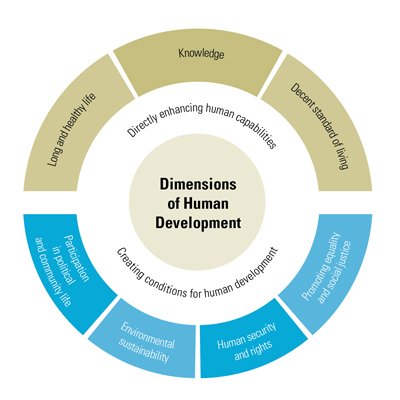Human development & Agenda 2030: Effecting positive change in people’s lives
By Selim Jahan, Director, Human Development Report Office, UNDP
 This September marked the first anniversary of the adoption of the 2030 Agenda for Sustainable Development and the 17 Sustainable Development Goals (SDGs). As we shift into the implementation phase, increasingly I am asked: “How is the concept of human development linked to the 2030 Agenda? How is it relevant to the achievement of the new goals?”
This September marked the first anniversary of the adoption of the 2030 Agenda for Sustainable Development and the 17 Sustainable Development Goals (SDGs). As we shift into the implementation phase, increasingly I am asked: “How is the concept of human development linked to the 2030 Agenda? How is it relevant to the achievement of the new goals?”
The UN Millennium Declaration and the Millennium Development Goals already mirrored the basic principles of human development – expanding human capabilities by addressing basic human deprivations (ending extreme poverty and hunger, promoting good health and education, etc.). The SDGs are a product of a global conversation involving a broad range of stakeholders from all over the world and all segments of society. It has been heartening to see that this highly consultative process resulted in a new global agenda that is even more fully reflective of human development principles.
The new agenda is committed to strengthening human capabilities, as well as voice, participation, gender equity, social justice and sustainability for all. It promises to “leave no one behind,” neither those in poverty nor those facing discrimination, neither in present nor future generations. In the human development approach, this is articulated as the “universal life claims” that form the foundation of our work. It’s the idea that every life has value, and every life is equally valuable.
In this regard, the human development principles and framework can provide intellectual contributions to the 2030 development agenda and the SDGs implementation. How?
To start, the principles and framework can offer a perspective to better understand the connectedness among the different goals and how holistic policy approaches will strengthen progress. At the same time, the narrative of the new agenda can enrich human development analysis, helping to expand its frontiers by highlighting elements that deserve fresh exploration to fit today’s development landscape. For example, access to information and communications technology (ICT), part of Goal 9, will significantly affect the choices and opportunities available to people everywhere. Inexpensive and reliable access to the Internet may enable other capabilities in the areas of education, work and political participation, among others, when well managed. But there are stark differences across the globe. While 79% of people in Europe use the Internet, only 25% of those in sub-Saharan Africa and only 6% of the population in least developed countries are Internet users.
Synergies also exist at the measurement level. The 17 SDGs are associated with specific targets and indicators to monitor progress. The indicators are a product of an intergovernmental process; UN member states have agreed on them. Human development measures can be aligned to some of those indicators and contribute to tracking progress in areas such as education, inequality and women’s empowerment, particularly at the national level. And as each Human Development Report (HDR) is intended to add value to the development discourse by applying a human development lens to a topical issue, these reports also can spotlight areas where progress is lacking. National and regional HDRs, for instance, often investigate sub-national patterns of development to put a spotlight on disparities among various areas of a country. In Mongolia, the Human Development Index (HDI) for the Ulaanbaatar capital region was 0.812 in 2014, while that in the Khovsgol region was 0.634. In Nigeria, while the maternal mortality ratio in Imo province was 111 per 100,000 live births in 2014, the comparable figure for the Kwara province was 489 per 100,000 live births – more than four times that of Imo.
Likewise, human development measures can take advantage of the SDG indicators as they evolve over the next 15 years. Since their inception, HDRs introduced a range of composite human development indices and indicators to capture inequalities and the nature of extreme poverty, including the signature Human Development Index,which generates headlines across the globe by showing average progress in basic human development at the country level. With the implementation of the 2030 Agenda, we can expect a wider range of data and indicators that are relevant to assessing human development more broadly in areas, for example, such as sustainability.
The next global HDR will consider how to achieve human development for everyone. It applies a human development perspective to the 2030 Agenda’s notion of leaving no one behind. It will present principles, analysis and policy options at the national and global levels. We seek to contribute to the 2030 Agenda for Sustainable Development by leveraging such linkages to effect positive changes in people’s lives.




